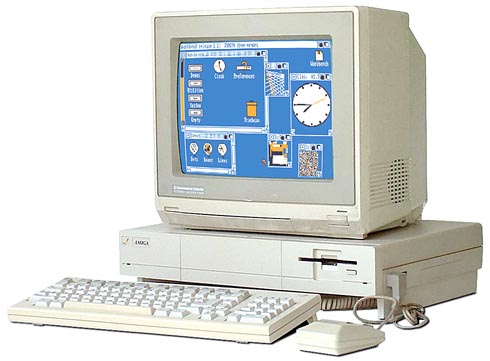Computer facts
| Company | Commodore |
|---|---|
| Type | home |
| Year | 1985 |
| End year | 1987 |
| CPU | Motorola MC68000 |
| Speed | 7.14 MHz |
| RAM | 256 KB (internally upgradable to 512 KB, 8 MB with extension card) |
| ROM | 8 KB (AmigaOS loaded from floppy) |
| Sound | 4 channels, 8 bit PCM |
| OS | AmigaOS |

In my collection
Commodore Amiga 1000
Donation from Peter Bortas.Trivia
The A1000, or Commodore Amiga 1000, was Commodore's initial Amiga personal computer, introduced on July 24, 1985 at the Lincoln Center in New York City. Machines began shipping in September with a base configuration of 256KB of RAM at the retail price of US$1,295. A 13-inch analog RGB monitor was available for around US$300 bringing the price of a complete Amiga system to $1,595. Before the release of the Amiga 500 and A2000 models in 1987, the A1000 was simply called Amiga or The Amiga from Commodore.
The A1000 had a number of characteristics that distinguished it from later Amigas: It was the only model to feature the short-lived Amiga "checkmark" logo on its case; the case was elevated slightly to give a storage area for the keyboard when not in use (a "keyboard garage"); and the inside of the case was engraved with the signatures of the Amiga designers, including Jay Miner and the paw print of his dog Mitchy.
Because AmigaOS was rather buggy at the time of the A1000's release, the OS was not placed in ROM. Instead, the A1000 included a daughterboard with 256 KB of RAM, dubbed the "Writable Control Store" (WCS), into which the core of the operating system was loaded from floppy disk (this portion of the operating system was known as the "Kickstart"). The WCS was write-protected after loading, and system resets did not require a reload of the WCS. In Europe the WCS was often referred to as WOM (Write Once Memory) as opposite to ROM (Read Only Memory).
Many A1000 owners remained attached to their machines long after newer models rendered the units technically obsolete, and it attracted numerous aftermarket upgrades. Many CPU upgrades that plugged into the Motorola 68000 socket functioned in the A1000. Additionally, a line of products called the Rejuvenator series allowed the use of newer chipsets in the A1000, and an Australian-designed replacement A1000 motherboard called The Phoenix utilized the same chipset as the A3000 and added an A2000-compatible video slot and onboard SCSI controller.
In 2006 PC World rated the Amiga 1000 as the 7th greatest PC of all time. In 2007 it was rated by the same magazine as the 37th best tech product of all time. In 1994, as Commodore filed for bankruptcy, Byte magazine called the Amiga 1000 "the first multimedia computer... so far ahead of its time that almost nobody--including Commodore's marketing department--could fully articulate what it was all about."
